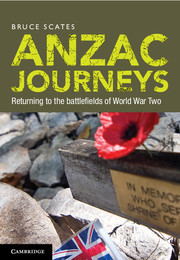Book contents
- Frontmatter
- Contents
- Maps
- Illustrations
- Acknowledgements
- Money, measurement and terminology
- Introduction
- PART 1 CAPTIVITY NARRATIVES
- 1 ‘If only I knew what has become of him’: The loss of Australia's prisoners of war
- 2 Witness to war: The first journeys
- 3 Bring up the bodies: Commemorating our war dead
- 4 Unspeakable histories: From Singapore to Hellfire Pass
- 5 The Death March: Journeys back to Sandakan
- PART 2 DESERT AND ISLAND
- PART 3 AIR AND SEA
- PART 4 AUSTRALIA'S FRONT LINE
- Conclusion
- Notes
- Index
3 - Bring up the bodies: Commemorating our war dead
from PART 1 - CAPTIVITY NARRATIVES
Published online by Cambridge University Press: 05 June 2013
- Frontmatter
- Contents
- Maps
- Illustrations
- Acknowledgements
- Money, measurement and terminology
- Introduction
- PART 1 CAPTIVITY NARRATIVES
- 1 ‘If only I knew what has become of him’: The loss of Australia's prisoners of war
- 2 Witness to war: The first journeys
- 3 Bring up the bodies: Commemorating our war dead
- 4 Unspeakable histories: From Singapore to Hellfire Pass
- 5 The Death March: Journeys back to Sandakan
- PART 2 DESERT AND ISLAND
- PART 3 AIR AND SEA
- PART 4 AUSTRALIA'S FRONT LINE
- Conclusion
- Notes
- Index
Summary
Before the cemeteries of World War II could be established, War graves units marked graves and recovered bodies. Thousands of men were buried along the course of the Thai–Burma railway, and one of the first tasks of the Imperial War graves Commission was to concentrate and rationalise these isolated burials. Major cemeteries were established throughout South-East Asia and across the globe, and none were exclusively Australian. The dead were often clustered in plots determined by their nationality.
Sticpewich, Babb and Simpson, whose stories formed the basis of chapter 2, made their respective journeys in the immediate aftermath of the war. The first major pilgrimage to a POW site in South-East Asia did not take place until a decade later, and as late as 1967 a cemetery on Ambon was still incomplete. This is in contrast to the surge of commemorative work that followed the Great War. Throughout the 1920s more than a thousand cemeteries were established across the Western Front alone, a mammoth building task Kipling likened to the pyramids of Egypt. All told, these cities of the dead contained the bodies of more than a million men. The Australian military casualties of World War II were half those of World War I, the fields in which they were buried had not been ravaged by four years of largely static carnage, and there were far fewer ‘missing’ men.
- Type
- Chapter
- Information
- Anzac JourneysReturning to the Battlefields of World War Two, pp. 52 - 73Publisher: Cambridge University PressPrint publication year: 2013



